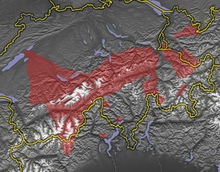Highest Alemannic
| Highest Alemannic German | |
|---|---|
| Region | the Alps |
|
Native speakers
|
about 500,000 (date missing) |
|
Indo-European
|
|
| Language codes | |
| ISO 639-3 | Either: gsw – Swiss German (partial) wae – Walser German |
| Glottolog | None |

Areas where Highest Alemannic dialects are spoken are marked in red.
|
|
Highest Alemannic (Hegschtalemannisch) is a branch of Alemannic German and is often considered to be part of the German language, even though mutual intelligibility with Standard German and other non-Alemannic German dialects is very limited.
Highest Alemannic dialects are spoken in alpine regions of Switzerland: In the Bernese Oberland, in the German-speaking parts of the Canton of Fribourg, in the Valais (see Walliser German) and in the Walser settlements (mostly in Switzerland, but also in Italy and in Austria; see Walser German). In the West, the South and the South-East, they are surrounded by Romance languages; in the North, by High Alemannic dialects. In the Swiss canton of Graubünden (Grisons) only the Walser exclaves in the Romansh part and the Prättigau, Schanfigg and Davos are Highest Alemannic; the Rhine Valley with Chur and Engadin are High Alemannic.
The distinctive feature of the Highest Alemannic dialects is the lack of hiatus diphthongization, for instance [ˈʃniː.ə(n)] 'to snow', [ˈb̥uː.ə(n)] 'to build' vs. High Alemannic [ˈʃnei̯jə], [ˈb̥ou̯wə].
...
Wikipedia
